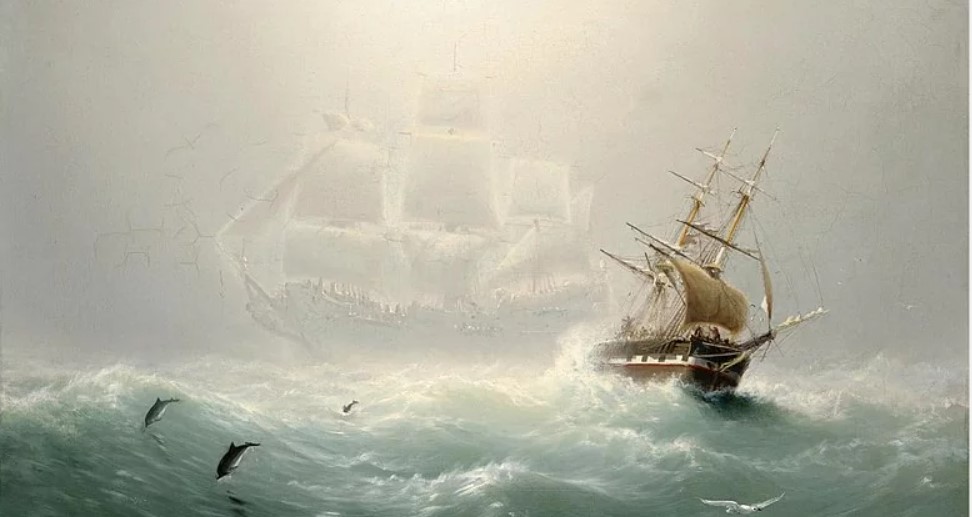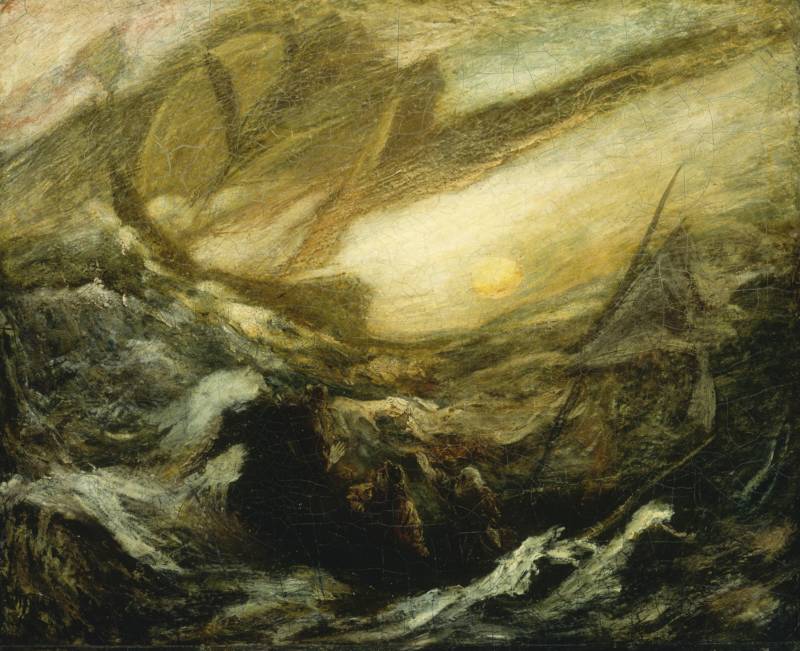
flying dutchman
The Flying Dutchman is a ghost ship is a legend that has been plaguing the high seas for centuries.
One legend of the Flying Dutchman has been talked about since the 17th century.
The story goes that Captain Hendrick van der Decken (the Dutchman of the Flying Dutchman) left Amsterdam for the East Indies where he loaded his ship with spices, silks, and dyes in 1641.
As the Captain and his ship rounded the Cape of Good Hope a violent storm came upon the crew. It’s assumed that they begged the captain to turn back to avoid certain doom but Captain Hendrick van der Decken ordered them forward into the gale.

Some believe van der Decken was mad while others said he was drunk.
As the storm worsened that the Flying Dutchman took a beating they attempted to make port the ship, with her crew, sank into the murky depths of the ocean. The captain and her crew were doomed to sail forever.
Another is of Captain Bernard Fokke or Falkenberg who sailed for the Dutch East India Company.
The captain was able to sail from Amsterdam to Indonesia in 3 months’ time, which was incredible for the 17th century. Many speculated that Captain Fokke traded his soul to the devil in order to achieve such speed.
The price he and his crew had to pay was sailing the ocean for all eternity.
There have been so many versions of the Flying Dutchman in film and literature. Davey Jones captained the ill-fated vessel in Pirates of the Caribbean while a cartoonish specter appeared on Spongebob Squarepants
Over the centuries there have been many sightings of the ghostly ship that is said to be a harbinger of doom.
Sailors who were unfortunate enough to see her believed it meant an ill omen was on the horizon, and worse still was when the ghostly ship tried to make contact.
George Barrington, 1795
George Barrington from London served time in Botany Bay, Australia, in the late 1700s for pickpocketing. He later became a pioneer and author and wrote about the legend he heard regarding the Flying Dutchman. In his story, two Dutch ships sailed together toward the Cape of Good Hope when a storm overcame them. One made it to shore, while the other one sank along with all of its crew. When the surviving ship left the Cape to head back to Europe, it encountered another storm. In the dark clouds, crew members believed they saw their companion vessel that sank. When they arrived at the port, they told everyone about their ghostly sighting and called it the Flying Dutchman.
Some of the people saw, or imagined they saw, a vessel standing for them under a press of sail, as though she would run them down: one, in particular, had affirmed it was the former ship that had foundered in the former gale, and it must certainly be her, or the apparition of her; but on its clearing up, the object, a dark thick cloud, disappeared.
George Barrington
John Leyden, 1803, & Others
Later, other ideas about the phantom ship followed. For example, in author John Leyden’s write-up, the sailors aboard the vessel had committed some crime. God punished them with a dreadful disease, and because no port allowed their entry, they had to sail the seas until judgment day. Sir Walter Scott connected the vessel to piracy and great treasures and said that a crewmate murdered another on board. Thomas Moore introduced the concept that the ship speeds along with full sails, even though there is no wind. Many variants of the tale say the captain swore to sail the seas forever, and the devil obliged him.
Samuel Taylor Coleridge
The “Rime of the Ancient Mariner” was a long poem written by the Englishman Samuel Taylor Coleridge in 1797-1798. It possesses a few elements of the Dutchman and is a great story. In it, a mariner, who is now living onshore, stops another man on his way to a wedding ceremony. He tells the man a tale about a strange experience he had on the sea long ago. During this sea voyage, the mariner shot an albatross. This resulted in a curse that sent the ship and crew into the Doldrums near the equator. For days and days, they were stuck and unable to go anywhere.
Then the mariner’s vessel encountered an old dilapidated ship, and aboard, two scary characters, “Death” and “Life-in-Death” were playing dice for the souls of the men on the mariner’s ship. “Death” won the souls of the crew, but “Life-in-Death” got the better prize, the mariner, who needed to suffer for his crime against nature. The crew all dropped dead, and eventually, the mariner wandered the earth in guilty penance having to tell his story over and over again to everyone he met.
Blackwood Edinburgh Magazine, 1821
Blackwood’s Edinburgh Magazine published a full story, Vanderdecken’s Message Home, about the Flying Dutchman in 1821. This version claimed that the Dutchman had left Amersterdam 70 years prior on its way to the East Indies for trade. Its commander, Captain Vanderdecken, brought a curse upon himself (and the crew) during an angry outburst in a storm as he tried to round the Cape of Good Hope. The devil heard his exclamation that he would “beat about here till the day of judgment” and damned him to remain in those seas. In the following excerpt, the Dutchman comes near the witnesses’ ship and makes contact:
“The next flash of lightning shone far and wide over the raging sea, and showed us not only the Flying Dutchman at a distance, but also a boat coming from her with four men. The boat was within two cables’ length of our ship’s side. . . . One of the men came upon deck, and appeared like a fatigued and weather-beaten seaman, holding some letters in his hand. Our sailors all drew back.
The chaplain, however, looking steadfastly upon him, went forward a few steps, and asked, ‘What is the purpose of this visit?’ The stranger replied, ‘We have long been kept here by foul weather, and Vanderdecken wishes to send these letters to his friends in Europe.’ Our captain now came forward, and said as firmly as he could, ‘I wish Vanderdecken would put his letters on board of any other vessel rather than mine.’ The stranger replied, ‘We have tried many a ship, but most of them refuse our letters.’”
Sightings of the Flying Dutchman Ship
King George & Prince Albert Victor
One of the most significant sightings of the ghost ship came from King George V of the United Kingdom. In 1880, he and his brother Prince Albert Victor were on a three-year voyage. On July 11, 1881, the Prince recorded a strange vision that appeared to them in the Bass Strait while aboard the HMS Inconstant.
He wrote that an encounter occurred at 4 am when the Flying Dutchman crossed their port bow. They saw “a strange red light as of a phantom ship all aglow, in the midst of which light the masts, spars, and sails of a brig 200 yards distant,” according to George’s description.
The officer on watch and several other sailors initially spotted the ship, but the vessel quickly disappeared. It didn’t end there, though.
George wrote that at 10:45 am, the sailor who had spotted the apparition suffered a gruesome fate. He fell from the masts onto the ship’s forecastle and died instantly. Naturally, everyone thought the phantom ship had been a supernatural warning of doom.
Bystanders at Glencairn Beach, South Africa
Although many sightings of the famous ghost ship have come from sailors out at sea, people on the shores also glimpsed the apparition. In 1939 and 1941, crowds of people at Glencairn Beach, South Africa, saw the Flying Dutchman under full sail on a collision course with the land.
According to a contemporary news report from the 1939 incident, the ship sailed on with “uncanny volition,” heading towards the shores of Strandfontein. Bystanders had a long, unobstructed view of the vessel before it disappeared in the blink of an eye.
Is the Flying Dutchman truly a doomed ship destined to sail the seas for all eternity with a cursed crew? Is it a harbinger of doom for those who see her?
What are your thoughts on the Dutchman? Do you think it’s Captain van der Decken or Captain Fokke?
Did the devil make a deal with a man who wanted earthly glory and now he’s paying the price along with the rest of his ill-fated crew?
Be sure to read more of our Case Files.





